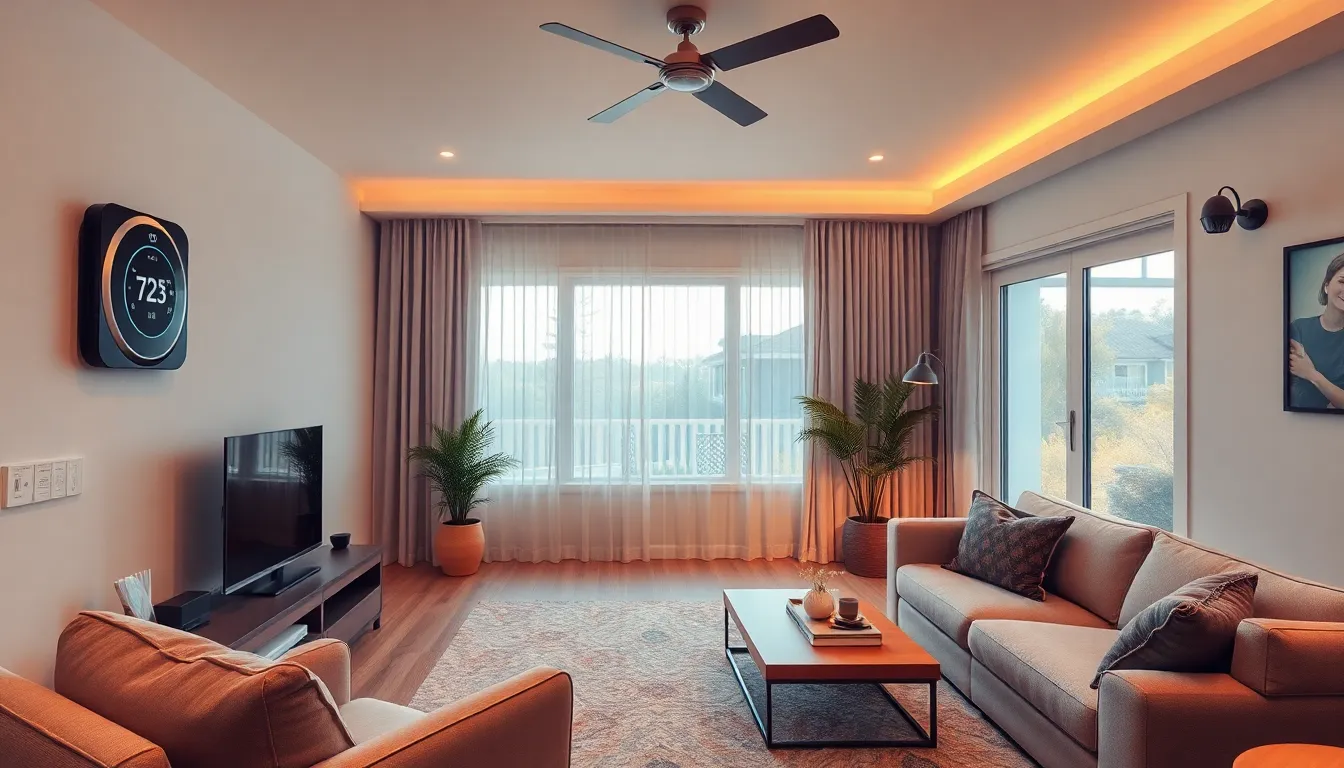Table of Contents
ToggleImagine walking into your home and having it greet you like a loyal butler. With smart home automation systems, that dream can become a reality. These systems don’t just offer convenience; they transform daily life into a seamless experience. From adjusting the thermostat to dimming the lights, it’s like having a magic wand—minus the need for a wizard’s hat.
Gone are the days of fumbling for light switches or worrying if you left the oven on. With a few taps on your smartphone, you can control your home from anywhere. Plus, your friends will be in awe when they see your home respond to your voice commands. It’s not just smart; it’s downright genius. Embrace the future and let technology take your home from ordinary to extraordinary.
Overview of Smart Home Automation Systems
Smart home automation systems offer unparalleled convenience by integrating various devices into a cohesive network. Users can control multiple functions such as lighting, heating, and security through a single interface. Smartphone apps enable remote access, making it possible to manage home systems from virtually anywhere.
Voice-controlled assistants add another layer of functionality. These systems respond to natural language commands, enhancing user interaction. Smart speakers activate lights or adjust room temperatures without the need for physical switches. Advanced sensors detect occupancy, optimizing energy use based on real-time data.
Interoperability among devices is crucial for maximizing benefits. Many systems support integration with third-party devices, allowing users to customize their setups. Popular platforms like Amazon Alexa, Google Assistant, and Apple HomeKit offer extensive compatibility with devices from various manufacturers.
Energy efficiency emerges as a key advantage of automation. Smart thermostats learn preferences over time, automatically adjusting settings to reduce consumption. Energy monitoring apps provide insights into usage patterns, empowering users to make informed decisions that save money.
Security features integrate seamlessly into smart home setups. Cameras, motion detectors, and alarms can be monitored remotely. Alerts sent directly to smartphones keep homeowners informed of suspicious activity.
Overall, smart home automation systems transform traditional living spaces into modern, responsive environments. They simplify daily tasks and enhance comfort while offering significant energy savings and improved security.
Key Features of Smart Home Automation Systems

Smart home automation systems feature multiple components that create an interconnected and efficient living space.
Device Integration
Integrating various devices into a smart home ecosystem enhances functionality. Users can connect smart lights with security cameras, allowing for seamless operation. Compatibility with platforms like Amazon Alexa and Google Assistant simplifies management. Homeowners can customize scenarios, such as setting lights to turn on when a security camera detects motion. Enhanced integration fosters a responsive environment that improves daily life.
Remote Access
Remote access enables users to control home systems from anywhere via smartphone apps. Users can monitor security cameras or adjust thermostat settings while away from home. Notifications alert users to any unusual activity, offering peace of mind. Adjusting lighting or heating schedules remotely further enhances comfort and convenience. This functionality allows for a connected lifestyle, ensuring that homeowners maintain control regardless of their location.
Energy Management
Energy management features help homeowners optimize their energy use and reduce costs. Smart thermostats learn user habits, adjusting settings to maximize efficiency. By analyzing usage patterns, these systems can suggest energy-saving changes. Automated schedules for heating and cooling minimize unnecessary consumption. Tracking energy usage through apps provides insights into consumption, promoting informed decisions and improving overall energy efficiency.
Benefits of Smart Home Automation Systems
Smart home automation systems offer numerous advantages that enhance daily living. Users experience immediate convenience and increased security while enjoying energy efficiency.
Convenience and Comfort
Smart home technologies streamline daily tasks, enabling users to control various functions with ease. Voice commands activate lights, adjust thermostats, and manage appliances, creating a more comfortable environment. Mobile apps allow remote monitoring and control, ensuring users can access their homes from anywhere. Automated schedules optimize system performance, enabling lights to turn on at sunset or the thermostat to adjust based on occupancy. This level of personalization makes life simpler, freeing users from mundane chores.
Enhanced Security
Smart home automation systems significantly boost security measures. Surveillance cameras offer real-time video feeds, while motion sensors alert users to unusual activity. Doorbell cameras enable residents to see who is at the door and communicate directly, enhancing safety. Homeowners receive instant notifications on their smartphones, ensuring they stay informed about potential threats. Remote locking features allow users to secure doors from anywhere, providing peace of mind while away from home.
Cost Savings and Energy Efficiency
Smart automation contributes to substantial cost savings through improved energy management. Energy-efficient devices, like smart thermostats, learn usage patterns and adjust settings automatically, reducing unnecessary consumption. Homeowners save an average of 10-30% on their energy bills by optimizing heating and cooling. Additionally, smart lighting systems allow for scheduled on/off times, further decreasing energy waste. Over time, these savings accumulate, proving that smart home automation systems not only enhance comfort but also promote financial efficiency.
Popular Smart Home Automation Systems
Smart home automation systems encompass a variety of options, each with unique strengths and weaknesses. These systems facilitate user customization and cater to diverse needs within smart living.
System Comparisons
Amazon Alexa offers an extensive ecosystem that supports numerous third-party devices. Google Assistant excels in voice recognition and natural language processing for intuitive user experiences. Apple HomeKit shines with tight integration across Apple devices, ensuring seamless operation. Comparably, Samsung SmartThings provides robust device compatibility and customization, appealing to tech-savvy users. Each platform presents unique advantages, allowing potential users to choose based on personal preferences and existing equipment.
Top Brands and Products
Nest and Ecobee dominate the smart thermostat market with their energy-efficient designs and user-friendly interfaces. Philips Hue stands out among smart lighting options, allowing users to create customizable ambiances. August smart locks enhance home security with their advanced features, including remote locking and monitoring. Ring is notable for its video doorbells and security cameras, offering peace of mind with real-time alerts. These brands excel within their categories, providing reliable solutions for smart home automation.
Challenges and Considerations
Smart home automation systems present various challenges that users must navigate. These include installation intricacies and privacy concerns.
Installation and Compatibility
Installation can become a complex process due to compatibility issues among devices. New users may find it challenging to determine which products work together. Various vendors have differing standards, causing potential integration problems. Some systems require specific hubs or controllers, complicating the setup even further. Establishing a cohesive network of devices is essential for optimal functionality. Choosing devices that support leading platforms like Amazon Alexa or Google Assistant enhances compatibility, simplifying integration. Additionally, considering future upgrades and expansions is crucial to ensure a lasting system.
Privacy and Security Risks
Privacy and security risks pose significant challenges for smart home technologies. Data breaches can occur if devices lack robust security measures. Sensitive information, such as user habits and security codes, may be vulnerable if proper precautions are not taken. Many devices collect and transmit personal data, raising concerns about unauthorized access. Users must regularly update device firmware to address potential vulnerabilities. Implementing strong passwords and enabling two-factor authentication can increase security. Moreover, reviewing privacy policies for each device helps ensure users comprehend how their data is used and stored.
Smart home automation systems are revolutionizing the way people interact with their living spaces. By offering convenience security and energy efficiency these systems create a modern lifestyle that adapts to individual needs. With seamless integration and intuitive controls users can elevate their homes into smart environments that simplify daily tasks.
As technology continues to advance the possibilities within smart home automation will only expand. Homeowners can enjoy the benefits of a connected home while remaining mindful of security and compatibility. Embracing these systems not only enhances comfort but also contributes to a sustainable future through optimized energy use. Investing in smart home automation is a step towards a more efficient and enjoyable living experience.






